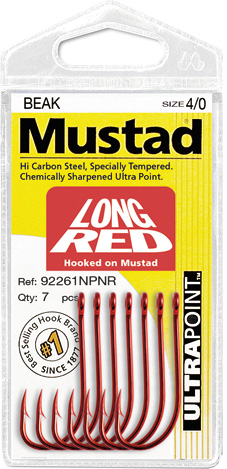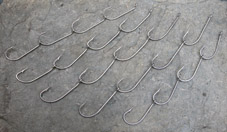By Alex Julius If there is one thing that the Mustad brand is known for in Australia above all other things, it is ganged hooks. The ganged hook and pilchard system originated in Australia as a tailor-catching technique and Mustad pioneered the special open-eye ganging hooks still in use today. And while the system’s popularity might have levelled in recent years due to the surge in lure and soft plastic fishing, there are still thousands of people out there doing it. So it is a good time to review, in consultation with Mustad’s experts, what’s happening in the world of ganged hooks. It turns out that there are some important new developments and some variations on the conventional ganged hook theme that are worth knowing about.
Originally, anglers made their own gangs by doctoring conventional closed-eye hooks like the Mustad 540 Viking, 8260 Limerick or 4200 Kirby. In the late 1960s, this tedious job was made easier when Mustad introduced the 4202D pattern, a Kirby style hook with an open eye which could be made into gangs simply by using pliers to squeeze the eye of one hook closed around the shank of the next hook. This system caught on quickly and became the conventional way of ganging hooks for tailor on the east coast.
The original Duratin plated version of the open eye 4202D has been improved on with the recent release of the 4202BLN. This new hook features an MT Point and a smooth black nickel finish for improved sharpness and better penetration. That might not sound like much of a change, but to ganged hook enthusiasts, these differences are important. The slippery black nickel reduces jamming of the hooks in the gang and that in turn reduces leverage on the hooks, which in turn reduces the risk of breakage or opening up. Greater mobility of the hooks in the gang also improves hookup power. Another feature of the 4202BLN is the modified shape and gap size of the open eye. Less bending is required to close the eye, resulting in less stress on the metal and more precise eye closure. Overall, the 4202BLN offers a much improved performance.
Ganging open eye hooks Ganging of open eye hooks is a pretty straightforward procedure, but there are some points of technique worth knowing. Before going further, I should give one very important warning: Eye protection is mandatory when making ganged hooks. During the hook-ganging process, breakages can occur, shards of sharp steel can fly around, or hooks can spring out of pliers, inflicting serious eye injuries. Closing the eye of an open eye hook involves bending tempered steel and that always weakens it. After assembly, the leverage of the shank of the upper hook increases the strain on the eye of the lower hook. Good eye closing technique can reduce the risk of eye breakage.
The objective is to get a nice, even, round eye; one which is tight enough to stop the barb pulling through, but not so tight as to cause the hooks to lock or jam. The trick is to make the eye curl around until it is closed, rather than just jamming it shut. Simply squashing each side of the eye will weaken the closed eye and create an oval shape, possibly allowing the barb to slide through. Having the right tool is a big help. Eyes should not be hammered shut, as this will seriously weaken them. Parallel action pliers with a slot down the centre of the jaw are about the best in the business (like the Sargeants fencing pliers). Place the open eye in this slot and squeeze it shut. The tag end of the eye will move in this slot and curl around to form a nice, circular closed eye. Also, you can improvise with a crimping tool, placing the hook eye in one of the cavities.
Swivel gangs from open eye hooks Swivel gangs are made using open eye hooks like the 4202 patterns but, instead of closing the eye of one hook directly around the next hook, the hooks are connected by swivels. The swivels act like universal joints, allowing each hook in the gang to move freely. This has several advantages, namely: • The leverage factor is almost entirely removed, so the risk of eye breakage is greatly reduced. • There are far fewer problems with gangs jamming or locking up. • The swivels extend the length of the gang, so you only need to use three hooks instead of four. Baiting up is easier and quicker. • The hookup rate is improved because each hook works independently; they don’t work against each other as they do with conventional gangs.
The technique is to slide the eye of the swivel onto the hook, via the tag end of the eye, then close the eye of the next hook around the swivel. The only things to watch out for are that the swivel eye is sized correctly so that it doesn’t slide over the barb of the hook, and that the swivel eye isn’t accidentally crushed when the eye of the hook is closed. As a rough rule of thumb, a size 10 barrel swivel usually fits a size 4/0 Mustad 4202D. But swivel eye sizing can vary from one make to another, so try them out first before buying a big quantity.
Making a swivel gang is probably the best thing you can do with open-eye ganging hooks. Swivel gangs are as convenient to use as conventional gangs but have far fewer disadvantages. They are every bit as good as conventional gangs for catching tailor and even more effective on other species. Conventional gangs were designed for tailor, a sharp-toothed, soft-mouthed fish that vigorously chews, worries and rattles the bait, making it easy to hook on conventional gangs. But other species are not so easy; hard-mouthed fish like snapper or bucket- mouthed fish like mulloway, for example. Soft-biting fish like bream and trevally love to munch on a pilchard, but are tough to hook on a conventional gang. But when each hook works independently, like they do in a swivel gang, the chance of a hookup is vastly increased.
Making gangs from closed-eye hooks Convenient though they might be, open-eye ganged hooks like the 4202 didn’t please everybody. Some preferred their ganged hooks to have straight points; the 4202 was offset (kirbed). Some preferred straight eyes; the 4202’s eye was turned down. Some preferred extra strength in the shank and bend; the 4202 was a regular-gauge hook. And some wanted to make gangs in super-small sizes to fish with small baitfish targeting flathead and bream. The 4202 was only made in sizes 6/0 to 1/0. In theory, you can gang just about any type of eyed or ringed hook either by opening the eyes or forcing the barbs through closed eyes, then straightening those same barbs afterwards. You can use special tools designed for that purpose, or sidecutters applied to the point where the eye meets the shank. But not all hooks tolerate this treatment. Remember that using force to manipulate the eye or barb of a hook involves bending tempered steel, so breakages are always a possibility — and in this context, the warning about the need for eye protection is repeated. But some closed-eye hooks still have a big fan club.
The classic Mustad Tarpon (7766D) has a strong cult following in several fishing areas, and it has become the norm for serious ganged hook fishing in Western Australia, largely due to its superior strength and ruggedness. The Tarpon has a straight eye (unlike the 4202) and most WA anglers like to keep it that way. With its shorter shank, the Tarpon is less inclined to produce a gang with a banana shape, so it has less need for a turned-down eye.
When Mustad built the Tarpon, it didn’t have ganged hook fishing in mind, but it so happens that the diameter of the Tarpon eye is not much smaller than the size of the Tarpon barb. So compared with most other closed-eye hooks, there is less drama in forcing the barb through the eye, or prising the eye open. Tarpons are a serious option for anglers wanting a stronger gang than the 4202 and a gang with straight (non-offset) points. Virtually every size in the Tarpon size range (12/0 to 6) can be deployed in some type of gang, ranging from giant mackerel gangs used with trolled herring, to tailor gangs in pilchards in sizes 6/0 to 3/0 size, right down to whitebait in mini-gangs of sizes 2 to 6 for flathead.
There is also the Red Tarpon (7766NPNR), Mustad’s chemically sharpened Ultra Point version of the Tarpon. It is the same basic shape as the classic Tarpon, but much sharper and with a higher strength to wire diameter ratio. Its size range of 7/0 down to 6 gives it plenty of ganging potential and its eye and barb is relativity similar to that of classic Tarpons. Many anglers gang them with great success. But as with chemically sharpened hooks generally, their harder steel makes them more resistant to eye-bending and point-pushing, so additional care is required.
Another closed-eye ganging hook of long standing is the classic Mustad Limerick 8260D. It’s not the most sophisticated hook in the catalogue, but it works mighty well. Many tailor anglers prefer this hook to the 4202 on the grounds of greater strength and better hookups due to the straight, non-offset point. For similar reasons, it is widely used in ganged hook trolling.
The Limerick pattern has a distinctive narrow bend which gives very good strength for a given wire diameter. So even though it has a longish shank, it holds together well under pressure. Available in sizes 12/0 down to 10, it is ganged for everything from mackerel to tailor and flathead. The Limerick in its natural state has a straight eye, although some anglers like to tweak the eye downwards slightly to avoid the banana effect.
Something different — Vinyl Gangs This is an adaption of a method used for linking trailer hooks on spinnerbaits and jigs. Purpose-built trailer hooks have an eye larger than the size of the barb, so the barb can pass through easily. A short length of vinyl tube is placed over the eye and the point and barb are pushed through the vinyl.
The Mustad Long Red hook lends itself perfectly to this treatment. A strong saltwater bait hook with offset (reversed) beak point and a medium-long shank, the Long Red (Ref: 92261NPNR) also has a straight, exceptionally large ring, which allows it to be vinyl-ganged very successfully. When treated this way, it produces a gang of similar dimensions to a conventional gang, but with no weakening of the eye. The steel hasn’t been bent back and forth, so it retains its full strength, so a gang of Long Reds can be fished to the max.
The Long Red is a fairly beefy hook in its own right, but the chemically sharpened Ultra Point gives it great penetration, so it is right at home on both regular sized tailor and bigger targets. The vinyl system creates stiffness in the gang which you don’t find in other gang types, but this doesn’t seem to affect hookup ability; in fact, it helps the pilchard stay in position and last longer. The vinyl sleeves hold the hooks firmly in position, so the eyes don’t need to be bent to avoid the banana effect.
With a size range of 7/0 down to 4, Long Red vinyl gangs can be made for target species from tailor right down to flathead. And because of their strength, Long Reds are great for making gangs used in heavy reef fishing. Those who haven’t tried this system are urged to do so. The vinyl tube sold in craft shops for covering coathangers is fine for this purpose.




